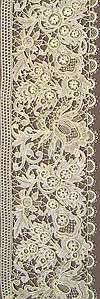Needle lace


Needle lace (also known as needlelace or needle-made lace or point lace) is a type of lace created using a needle and thread to stitch up hundreds of small stitches to form the lace itself.
In its purest form, the only equipment and materials used are a needle, thread and scissors. The origins of needle lace date back to the 16th century in Italy, its origins may be found in the openwork on linen technique called reticella.[1] a variety of styles developed where the work is started by securing heavier guiding threads onto a stiff background (such as thick paper) with stitches that can later be removed. The work is then built up using a variety of stitches—the most basic being a variety of buttonhole or blanket stitch. When the entire area is covered with the stitching, the stay-stitches are released and the lace comes away from the paper. See reticella.
Needle lace is also used to create the fillings or insertions in cutwork.
References
- ↑ Dillmont, Thérèse de (0192). Needle-made Laces: 1st series. Dollfus-Mieg. Check date values in:
|date=(help)
- "Structures of Antique Lace". A Collection of Antique Laces. Retrieved July 26, 2005.
External links

- Kenmare Lace And other forms of Irish Lace
- Needlelace - Lace Identification and Types
- Old Point Lace: How to Copy and Imitate It (1878) by Daisy Waterhouse Hawkins. Chatto and Windus, London.
